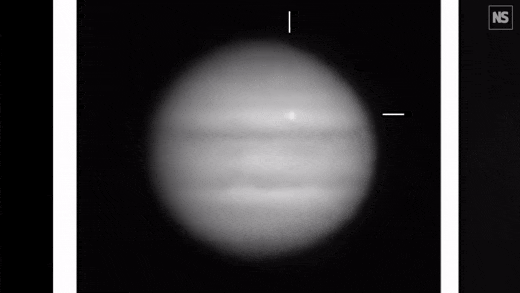Jupiter is the largest planet in the Solar System, both in diameter and in mass, and the fifth closest to the Sun. It is at an average distance from Earth of 628,000,000 km. It is therefore close, astronomically speaking, and accessible to the various human instruments that study it. Such proximity allowed him to realize that he was hit by something so big that it caused the biggest explosion and the biggest flash recorded on Earth in the last 28 years.
According to scientists, this explosion on Jupiter will have the force equivalent to 2 million tons of TNT. Although the impact took place some time ago, more details of this phenomenon are only now known.
At the end of last year, Jupiter was "bombed" with several space rocks and some caused huge flashes signaling colossal explosions. In September, the lens of Brazilian space photographer José Luís Pereira showed the impact of an icy asteroid on the planet. The images went around the world.
However, the following month, a space rock hit Jupiter's gaseous "surface" and the impact of that collision, which may have been the biggest in 28 years, was so strong that observers here on Earth were able to capture the phenomenon.
1994 explosion left scars on Jupiter
According to Kyoto University in Japan, this impact was the largest explosion recorded on Jupiter since 1994. It is important to note that in that year, when comet Shoemaker-Levy 9 collided with the giant planet, it caused an explosion equivalent to 300 million of atomic bombs and left marks on Jupiter's atmosphere.
According to NASA, after this impact in the 1990s, dark, ringed spots appeared in the planet's atmosphere. Over the years, astronomers realized that these spots faded and ended up disappearing by the winds of Jupiter.
The biggest explosion of the century on Jupiter
The collision took place on October 15, 2021, and was observed by the PONCOTS (Planetary Observation Camera for Optical Transient Surveys) instrument, which is operated by Kyoto University in Japan.
After the data collected, the university described the phenomenon in a study, which has not yet been peer-reviewed. In that document, it is described that the rock had a mass of about 4.1 million kg and between 15 and 30 meters in diameter, enough to release an impact energy equivalent to the Tunguska meteorite, which hit Earth in 1908, more specifically in Siberia, Russia.
To this day, it ranks as "the greatest cosmic impact witnessed" by modern humanity.
The reliable shield of the solar system
Various celestial bodies usually fall on Jupiter. Astronomers observe these events as flashes in the optical band. The main source of Jupiter's collisions is believed to be a group of short-period comets close to the gas giant's orbit.
Since 2010, astronomers have recorded six bright bursts of impacts, which, along with a nova from 2021, have helped scientists improve estimates of the frequency of such events on Jupiter.
In general, Jupiter is a reliable shield for the planets of the inner solar system. Its enormous gravity saves us, attracting most dangerous asteroids and comets, which without our giant planet could collide with Earth.
-



